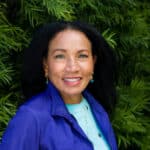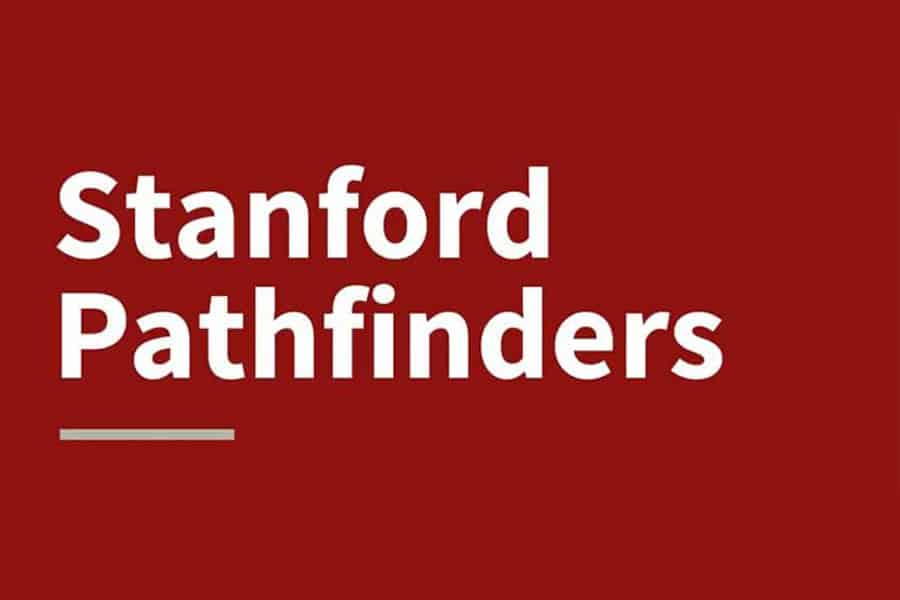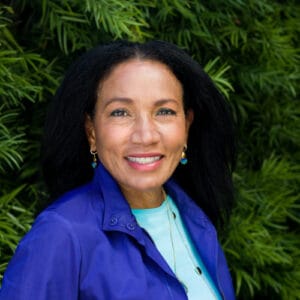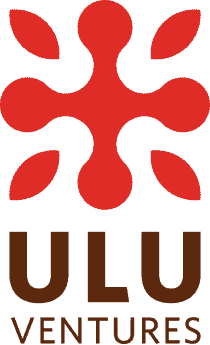Announcer: Sirius XM presents Stanford Pathfinders…
Howard: Stanford has 225,000 alumni living all over the globe in 151 countries. They are some of the most amazing people you would ever want to meet.
Announcer: A show about how the graduates of Stanford University are changing our lives and the world.
Howard: We’ll hear very interesting things from business leaders in the technology sector, but well beyond that, the worlds of politics, entertainment, business, and beyond.
Announcer: Inspiring stories from America’s innovation heartland.
Howard: It’s a place where people look to the future, not to the past, where they don’t rest on their laurels. Think about the Gold Rush. Think about Stanford being formed in the late 1800s. Then Stanford was the beginning of Silicon Valley. The ethos of Silicon Valley is deeply embedded in the Stanford spirit. It’s a spirit of innovation and experimentation. It’s a spirit of being willing to try new things and risk failure, as long as you fail forward.
Announcer: Welcome to Stanford Pathfinders.
Intro: This week on Stanford Pathfinders, an alumna who has lived all over the country but finally found a home in Silicon Valley.
Miriam: I was looking for the opportunity where people say, “Go west, young man.” I found it at Stanford University.
Intro: A businesswoman and venture capitalist who is known for being as kind as she is tough.
Miriam: When I think about business, I think about long term relationships and how much economic value they create. That is based on trust. A lot of the times, just being a nice person is one of the ways to build trust.
Intro: Today on Stanford Pathfinders, managing partner of Ulu Ventures, Miriam Rivera. Here’s your host, Howard Wolf…
Howard: Students come to Stanford from all over the world and they are diverse in all ways possible, from gender, race, ethnicity, and sexual orientation, to geography, political persuasion, social economic status, and beyond. For many, the travel to Stanford marks the first time they’ve ventured outside of their home city or state. For others, they come to campus with Passports brimming with stamps from around the globe. For all, they come for the opportunity to learn from Stanford’s professors and each other in this community of scholars, otherwise known as a university.
Today’s guest on Stanford Pathfinders is an alumna who makes us very proud. She hails originally from the inner-city of Chicago, where she grew up in a loving but very modest household. She went on to receive four degrees from Stanford, and then leveraged these degrees to find great success in Silicon Valley at high tech companies, most notably Google.
Miriam Rivera is now the cofounder and managing partner of Ulu Ventures, a top seed stage venture fund in Silicon Valley focused on information technology startups. Perhaps most impressively, Ulu is dedicated to increasing diversity in both the entrepreneurial and investment communities. And they deliver.
The firm has backed entrepreneurs who are quite diverse by industry standards, including approximately 30% women CEOs, 30% minority CEOs, and 10% minority cofounders. In Silicon Valley, an ecosystem that is known for being run almost entirely by white men, Miriam and her firm are challenging and changing the paradigm. Miriam, welcome to the show.
Miriam: Thank you, Howard. It’s great to be here.
Howard: You have an amazing life story and I hope you can share it with us. I love this quote of yours, “I’m an inner-city, Spanish-speaking, low income, free lunch, first in her family to go to college girl.” Can you tell us a bit about your family, where you grew up, how you ended up at Exeter and then Stanford, and how you end up getting not one or two but four degrees from Stanford?
Miriam: My family came to the mainland from Puerto Rico. My parents actually met in Florida, and we say that I was conceived in Florida and born in upstate New York, where my parents spent the winters picking the grape crop. My father had two brothers that lived there, so we stayed there over the winters, which makes no sense to me because I’d rather winter in Florida than in the Buffalo, New York area any day. But we went to Chicago when my sister was starting school, so we only had one school per year.
It was there that I met some amazing teachers who really took me under their wing, helped identify me as a gifted kid, and then encouraged me to apply to private high school. I went to Phillips Exeter Academy on a full scholarship, but I actually graduated from the Latin School of Chicago. I have to thank both my alma maters, because they were really instrumental in changing the trajectory of my life.
Howard: Do you even know what Phillips Exeter was when they started talking to you about going to this prep school?
Miriam: I had no idea. The teacher told me that they were having an open house at Water Tower Hyatt and that I should go downtown and attend an information session. I didn’t even know that you could go to a hotel if you weren’t a guest or didn’t work at the hotel, because the only people I knew who went to hotels were people who worked in the maid service, for example.
So, I attended the meeting, I saw the video, saw that 90% of these kids went on to the best colleges in the United States. I decided right then I’m going there. It was the only school I applied to. Very bad risk strategy there, but I got in. I did very well there. I ended up transferring to the Latin School of Chicago because I wanted to be in a more urban environment. I knew I’d go away to college and maybe never come home again, so I returned for the last two years in Chicago before coming out to Stanford University.
Howard: Why Stanford?
Miriam: Part of it was going out east. I had gone out east. Exeter, New Hampshire is a town of about 10,000 people and it’s a very traditional kid of culture. In those days, people would ask you questions like, “Are your people on the Social Register?” I didn’t even know what the Social Register was, and I didn’t know what the word ‘people’ meant in that context. You mean like Puerto Ricans? I had no idea.
I felt a bit like the east coast was maybe not the place with the most opportunities for people who hadn’t been long-time in the east coast and in the country.
Howard: You were looking for a meritocracy.
Miriam: I was looking for the opportunity where people say, “Go west, young man.” And I found it at Stanford University.
Howard: So, you come to Stanford and you get not one, not two, not three, but four degrees. You’re one of the few Stanford alums I’ve met with four degrees from Stanford.
Miriam: I got four Stanford degrees in part because I didn’t know what I wanted to be when I grew up. I came here, again, as a first-generation college student. I didn’t have parents who really could help me navigate the environment of thinking about college and then what do you do after college. My whole life had been about just getting here.
When I first graduated, I thought, “Well, I’ll go and become a professor,” so I studied and got a master’s in Latin American literature, thinking I’d get a PhD. I realized it would take me about 10 years to do that and that I’d have to leave Stanford and probably take a job anywhere in the country that would hire somebody to teach Spanish and literature. I realized that I might do better if I went in a professional track.
Ultimately, I came back to do the law and business degrees, and work right here in Silicon Valley, because I knew I wanted to stay in this community.
Howard: The proverbial JD MBA, at the time called the golden passport. It gave you all kinds of opportunities.
Miriam: It did. It also gave me all kinds of debt and it made me really nervous. The first few years that I graduated, I kind of considered myself to be in a bit of indentured servitude until I paid down my student debt and then could really pursue what I wanted to do, which was go into entrepreneurship and tech companies here in Silicon Valley.
Howard: I want to get back to that in a second. Before we do that, you mentioned these teachers and these mentors when you were a kid growing up in Chicago who saw your promise. What were the roles of these mentors and teachers? And do we put them on a pedestal enough here in this country?
Miriam: Oh, there’s no a pedestal high enough for the likes of Marsha Weinstein, or Michelle Creegor, or George Dreylios, who were these really influential teachers in my middle school years. Marsha Weinstein was a second-generation teacher, her mother had taught in the Chicago public schools before her. She came to this inner-city low-income community with the notion that we should be able to learn at the highest levels.
She went to used bookstores and bought all of these Penguin classics of things like Oliver Twist, The Grapes of Wrath, Upton Sinclair’s The Jungle, and she basically taught us vocabulary, reading comprehension, essay writing, and critical thinking using these books that she paid for with her own money. She was putting these in front of kids that most of us were growing up in homes where there were not many books.
Howard: Or there were no books.
Miriam: Here we are, she’s giving us the classics and she’s making us explore a theme, which it took me a long time to realize what she was doing, but all of these books were about kids that were growing up in poverty and what was going to be their response to the choices and circumstances of their lives. She really helped me to start thinking about a different kind of future and how my future wasn’t necessarily determined by my circumstance.
Howard: So, you leave Stanford’s JD MBA program in 2001. I’m sorry. In 2001 you joined Google as its second in-house lawyer. Those were crazy times at Google, if I recall. It was only two years old, it wasn’t yet public, and it had wild ambitions. Tell us a little bit about what it was like. How many people were on staff at the time? What was Google like back in 2001?
Miriam: When I joined Google, we were still all in one building. I was employee 160.
Howard: 160 at Google.
Miriam: 160. Now there’s probably over 100,000 employees worldwide, and contractors of course. It was a small place. Literally, engineers were making the rack servers in the hallways where we had to walk up and down the stairs. We had so little space that we were violating the fire code. We had to do interviews while walking around Shoreline Park, because there were no conference rooms available. So, we were growing very fast.
Howard: Explosive growth.
Miriam: Google was the fastest growing company in America at that point in history. We went from $85 million to $10 billion in revenue in five years. We went from 160 employees to over 10,000 employees and 5,000 contractors at that time. The first company to ever reach a billion users in the history of the world.
I want you to understand what that really means in context. The only other things that have a billion anythings are religions. So, we were really doing something that had never been done.
Howard: It must have been an amazing time. Were you just pedal to the metal, working all the time, no time for anything else? Was this your entire focus of your life?
Miriam: Well, yes, and my family. I had a daughter. I actually started with a 2-year-old in hand when I started at Google. There were times when she was coming to the cafeteria to have dinner with mom. There were other times when the company was sending out an IT person to help me work on my computer at my house, so that she didn’t have to get woken up and taken to the company. But both of these things were the focus of my life at that time.
Howard: If you read stories about Miriam Rivera, one of the words that comes through loud and clear in almost every story I read is the power of kindness. Kindness seems to be a theme that runs through your life. You talked about the mentors and the teachers that were kind to you, but it also is a big part of you as a businesswoman.
I have to tell you, I don’t hear the word kindness and business together in a sentence often. Talk to me about what that means. What’s this whole thing about kindness and business?
Miriam: I have to say that I’m also known for being a truth-teller in business.
Howard: You’re kind and tough.
Miriam: I can be kind and tough. I think the notion of kindness is that oftentimes we’re actually going to be able to hear and understand the other side a lot more if we are open to receiving what it is they have to tell and show us.
When I work on a deal, for example, one of the things that I do is try to look at everything from the perspective of the other side. Part of that means what are the things that they care about? Why is it that this is hard for them to give? Understanding what makes them tick as people and being able to form better bonds with them has made it so that I’ve been able to close pretty much all of the transactions that I’ve ever set out to do.
Most of those transactions continue to exist. Most of them never went into litigation. That means that the billions of dollars of revenue that I helped Google to negotiate in the first few years continue to be the foundation of revenue for the company on a moving forward basis. When I think about business, I think about long term relationships and how much economic value they create. That is based on trust. A lot of the times, just being a nice person is one of the ways to build trust.
Howard: Now you’re in the venture capital business, you’re the founder and comanaging partner with your husband of Ulu Ventures. You have to tell me, where did this name come from, Ulu?
Miriam: I’m a big fan of Hawaii.
Howard: I am as well.
Miriam: Puerto Rico is so far from here that it takes at least two planes to get there, whereas Hawaii is only one flight. I found the word and it means to grow and inspire in Hawaiian. That seemed like a good word to be associated with a startup seed stage funder.
Howard: All right. Ulu Ventures has one of the most diverse portfolios of entrepreneurs in Silicon Valley. You’ve been quoted as saying, “We’re not sacrificing anything by investing in women and minorities.” How do it? Is that why you started this firm or is that your competitive advantage, that you’re able to find these women and people of color who’ve run these companies, these entrepreneurs?
Miriam: I think we’re able to both identify great women CEOs, minority CEOs, as well as mainstream CEOs. We have an incredible relationship here with alums from the Stanford community, with students from the Stanford community, even faculty here that have started companies. That has given access to great talent.
What I want to say is that there’s a notion sometimes that there’s a pipeline problem in terms of accessing diverse talent. But venture capital is only given to the top 1% of companies in the United States. There are way more people that could have access to venture capital than do have access to venture capital that are diverse.
Part of it is that people tend to continue to invest in what they’ve seen and heard as successful, and they’re less aware of what’s really been happening in great places like Stanford University. Which is that the number of people that are coming here from around the world to attend graduate programs and the caliber of those people is second to none.
In fact, education has gotten way more competitive over time. Women have actually surpassed men in terms of education attainment in this country. If you think about the rate of higher education attainment by Asians, it’s about 60%, compared to 40% for whites.
Why is it that there aren’t Asian entrepreneurs? It’s not that they don’t have technical degrees that are desirable from top universities. It’s sometimes that they’re overlooked because they may not fit the mold of what we consider an entrepreneur. They’re not brash, they’re not tall, they’re not male, they’re not louder.
Howard: Brash, tall, male, louder. The industry in which you work, the venture industry as well as Silicon Valley in general, is known for being mainly male, mainly white, and pretty conservative in the way that they look at deals. I guess my question is why is it that the Valley is so lacking in diversity at the highest levels?
Miriam: I think venture capital has been a space where people grew up in the industry, and traditionally technology was a very white male dominated industry. But, as we’ve seen at Stanford, the demographics of who is attending graduate programs in the sciences, in computer science, in math, has really shifted dramatically over the last 20 years.
That’s because we’re accessing talent at a global level. Also, we’re promoting talent from within our own country. Diverse access has just increased so much. But the venture capital industry tends to be relatively traditional, because the big funders of venture capital firms have typically been pension funds, not the fastest-acting fastest to change type of organizations.
Howard: If you look at the portfolio of companies that Ulu has invested in, I think that it said something like 30% of the companies are run by women, 30% of the founders are minorities. Is that a special cache that your firm has in the Valley? If I’m an entrepreneur and I’m female or I’m of color, I’m going to go to Ulu, because you’re going to look at me in a different way than some other firm might look at me.
Miriam: We definitely think that we have a competitive advantage because we have that kind of diversity in our entrepreneurial portfolio, and we also believe that people feel that they are given a true shot at access to that venture capital.
Howard: Being Latina, is there a special place for you in this pantheon of venture capitalists, do the Latino and Latina entrepreneurs want to come to you?
Miriam: We do think that we get a competitive advantage there. For example, one of our entrepreneurs – Tom Chavez, who was a PhD student here at Stanford University in the engineering school, was a first-generation college student on a scholarship before then – he had access to capital from a firm like Accel, which is one of the leaders in the market, they were one of the funders of Facebook, they have a tremendous reputation. Yet he wanted to make sure that there was diverse funders within his community of investors, and because of that Ulu was able to invest in his company, which sold to Salesforce recently at about a $1 billion value.
Howard: Ulu has a particular investment thesis that focuses on being data-driven and at the same time looking for the diversity that you and I have just been talking about. I found it fascinating as I read more about your firm and the data-driven nature of the way you make decisions. Is that to say that the vast majority of venture deals are sort of gut?
Miriam: I have to say that a lot of venture decision making is around what people call pattern matching. They’re looking for some of the same kinds of things that have worked in the past. Again, you’re going to have a bias when you are looking at what’s worked before as opposed to thinking about what is going to work on a moving forward basis.
What we do is when we look at an investment, we try to quantify both the risk and the opportunity of that investment. That’s something that’s actually also different from what happens in traditional venture capital. A study out of Harvard Business School talked about how people interact with women versus male CEOs, for example. They determined that VCs of both genders tended to ask women questions that were focused on risk and they tended to ask men questions that were focused on opportunity.
The questions you are ask are more likely to bias your outcome. If you think only about the downside of something, you’re probably going to pass on it. Whereas, if you’re thinking only about the upside of something, you’re more likely to take a risk. We try to do both and combine it for all of the investments that we make.
Howard: You’re actively thinking about this as you interview potential entrepreneurs for your fund. You’re thinking about exactly that, asking both about risk and opportunity, and not to be biased in the way that you approach one gender versus the other.
Miriam: Right. We use them a methodology that was developed here at Stanford University by Professor Ron Howard that’s called decision and risk analysis, where a lot of the cognitive psychology of folks like Amos Tversky, also of Stanford University, helped to reduce the kinds of bias that would go into making a decision. We think that’s why we’ve come out with the outcomes that we have at the same time as being a to 10% returning fund.
Howard: I have to imagine that listening right now are thousands upon thousands of future entrepreneurs who are listening with great interest in what you’re saying. So, let’s talk about entrepreneurs. You see entrepreneurs all the time and you probably have a PhD in mastering the assessment of entrepreneurs.
What makes an entrepreneur a success? Is it brain power, a great idea, determination, grit, luck? What’s the magic formula that makes an entrepreneur someone that you say, “I’m backing her?”
Miriam: I would say there’s a combination of these things that are going to be really important. It is very helpful to have past experience in the industry in which you’re developing a product. Why is that important? Because you’re going to understand the problems, you’re going to understand what’s available competitively in that market, and you’re going to understand why something either hasn’t taken off or needs to be built that solves a problem that really hasn’t been solved well before.
Experience does matter in our type of investing, because we tend to focus on businesses that sell to other businesses, as opposed to consumer-oriented businesses like a Facebook. The other thing that we’re looking for, though, is why is that problem a meaningful problem for you to solve. The things that make something meaningful are what gives somebody stick-to-itiveness, or grit, as you say.
One of the things that we’ve seen, for example, we have a company that’s in the internet-of-things space, they help develop sensors that help automate factories so that people can get data from all of the many types of machines that are on the factory floor and be able to do better production more cost effectively with less waste. These young folks started out as Peace Corp volunteers and they wanted to help people to test the quality of water in wells.
They started developing sensor technology that could do this, but a lot of the times these water sources were kind of far from the villages that they were working in and they realized they would need a much more complicated system that would be able to communicate from the well the quality at the well and whether or not you should actually walk those eight miles to the well to get water. They had an intense passion around trying to create an affordable sensor that could be implemented in really tough conditions. They did that as a not for profit for years before they actually started a for profit company. These were Stanford PhD students.
Howard: Let’s look at your crystal ball and ask you to tell us what you see as big winners in the venture world in the next five to 10 years.
Miriam: In the next five to 10 years, I really think that AI, artificial intelligence, and then internet-of-things, which is where we’re essentially connecting the physical world to the internet in order to be able to make more data-driven decisions in a variety of areas that haven’t been technologized before. Including areas like fabrication and agriculture. We’re seeing more and more of that. I think that that’s the wave of the future. Now, one thing is I think AI is a little hyped at the moment.
Howard: You can’t pick up a magazine today without having at least one or two stories be about artificial intelligence and machine learning. I know those are related to each other, I have no idea what the difference is. That’s what you read. You think it’s a little bit overhyped right now?
Miriam: I think it’s a little overhyped right now, because a lot of the applications require so much access to data that most of these companies will never have sufficient access to data to be able to do good artificial intelligence development.
Now, it’s a scalable technology, though. The longer people are in business and the bigger the data sets, the more able technologies are to train themselves. It’s just not as possible for most startups to do a very good job at this as it might be for a very large company, like a Google, that access to tons of data.
Internet-of-things is another space that I think is the wave of the future. Everybody wants to know how to do their job better. If I’m a farmer and I have all these fields, I’d like to know which of them can I water today and which of them can wait another day, so I can make better uses of my water resources, for example.
Howard: There might be sensors that are connected to the internet that can inform where you’re going to water.
Miriam: Right from my cellphone at my farmhouse or in my farm office, I can be tracking if there is a problem in a certain part of my fields, how much water I need over there. That’s the kind of thing that is going to make us more efficient in agriculture and is going to help people do a better job with less.
Howard: What would you tell a young person today, maybe someone who is in college today or maybe someone who is in high school and is going off to college in the next couple of years, and they want to do what you do? You’re their role model. What advice would you give that young woman today about what she should be thinking about to attain that level of professional success, to be in the venture business like you are in and change lives like you do every day?
Miriam: One thing I want to say is that there are so many different paths to the future that you envision for yourself. While I took a very traditional path, I went to great schools, I had a tremendous worth ethic, I have to say.
Howard: Four degrees from Stanford.
Miriam: And I started working when I was 13 years old and I probably put in 60+ hours a week during most of the time I have been a working person. That’s one path. It was my path. I’ve also seen people like Arlan Hamilton at Backstage Capital who worked as a crew member for musicians and rock shows, and who has also been able to raise a fund in Silicon Valley that is targeting diverse managers. At one point, she was sleeping on people’s couches, she didn’t have a place to live.
Both of us have ended up doing something where we think we can help entrepreneurs – diverse entrepreneurs – be able to access capital and create better services and technologies for people. I just want to say there is no one path, you have to create your own.
Howard: Miriam, this has been an absolutely pleasure. Thank you so much for being on the show.
Miriam: Thank you, Howard. It’s always a pleasure to see you.
Howard: Thank you for listening to Stanford Pathfinders on Sirius XM Insight. Listen to this and other episodes anytime on-demand with the Sirius XM app.






